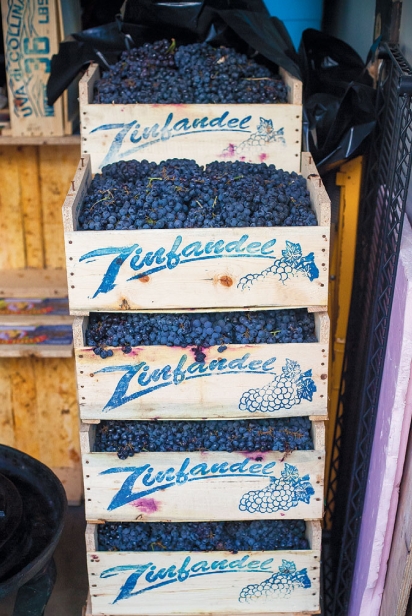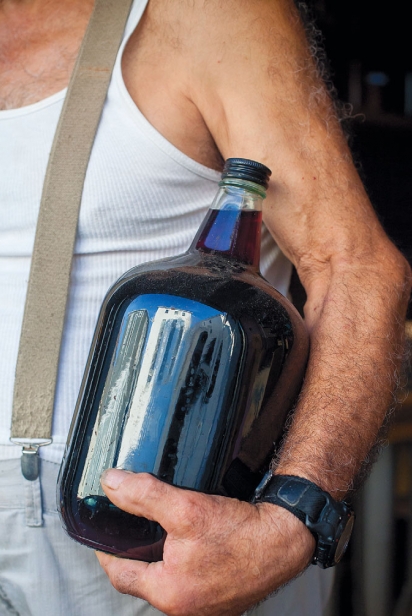Winemaking the Old-Fashioned Way
An Italian Tradition in Providence
Behind an unassuming garage door on the west side of Providence stands Gino Milano and his vintage winemaking operation. Gino is a winemaker of the purest kind, who has been taking part in this annual ritual nearly his entire life.
The early winemaking days were centered around Gino’s family in his native Naples, Italy. As a child he, alongside multiple generations of the Milano clan, learned to press grapes the old-fashioned way—with his feet, in wooden barrels, similar to the barrels he uses today. His father and grandfather were the winemakers then; the children took delight in stomping the grapes. Many decades later this family ritual continues at Gino’s home near Federal Hill.
It’s been 47 years since Gino (now in his 70s) came to Providence from Italy, but the Italian traditions from his youth keep a strong hold on the rich life he’s created here. He is, like an Italian man of any age, incredibly proud of the small corner of the world that he has created and takes joy in sharing it. Gino’s driveway has no cars but instead there is a small seating area surrounded in summer by fig trees, tomatoes, herbs and other vegetation. At the holidays this area turns into an elaborate presepe, or nativity scene, that attracts sightseers. Dressed in a daily uniform of suspenders and slacks, he tends to his home and yard with incredible care and patience. Gino lives with his wife, Seba, and together they raised a family with equal attention.
The winemaking magic happens across the street in a neighbor’s one-car garage and the tender care Gino exudes follows him there. Packed neatly with all of his equipment, the space quietly awaits the harvest of grapes from California each September. There are 70-year-old oak barrels cared for in the heat and cold, an even older grape press that Gino cleans and treats with olive oil after each use and a collection of glass bottles and jugs, large and small, that have been reused for decades.
A call to a local purveyor, Al-Jac’s Wine Grapes on Hemlock Street, in mid-September sets Gino in motion. When the grapes arrive from the West Coast he selects them carefully, waiting a number of days for each crate to air dry before beginning. It’s taken several years of experimenting with domestically grown varieties (Bambino Bianco, Sauvignon Blanc and Merlot, among others) before Gino found the two varieties that please him the most: Zinfandel and White Moscato. He makes about 95 gallons of each.
Many large-scale wine producers today use additives (such as sulfur) in their winemaking process for flavor, intensity and structure. Gino’s garage wine process in contrast is 100% natural, using zero additives. While he may be following the natural wine trend emerging today from small producers, “natural” is the he only way he knows and wouldn’t think of adding anything extra to his wine.
“Technology is taking over humans but it’s not going to take me over,” he says, as he proudly takes stock of the few remaining bottles from last year.
Once the grapes are ready, Gino cleans out any remaining sticks and leaves and dumps them in the wooden grinder that he cranks by hand. The crushed grapes drop into the oak barrels and from here he lets the fermentation begin without much interference. Once during the next two to three days Gino will push the grapes down with a wooden stick until the liquid bubbles to the surface once again. After sitting in the barrels, the grapes are put through the press before the glass jugs and bottles are filled with the juice to finish fermenting. Gino caps each bottle when ready—and then they sit.
November 11 marks the Feast of San Martino, the patron saint of wine and winemaking. This is the day across Italy and in the homes of many winemakers that the vino novello (young wine) is poured for the first time. Following the saying “ogni mosto e vino” (every juice becomes wine) The Feast of San Martino is a celebration and preview of what is to come. Sips of the immature wine hint at the quality and flavor profiles of that year’s vintage.
Every year on San Martino Gino cleans out each jug and bottle, getting rid of the sediment that has settled at the bottom. The wine returns to the jugs, untouched until Christmas Eve, when Gino and his family open two gallons of the new wine for the holiday. After one more transfer and sediment cleansing in January, the wine bottles are ready to be opened and shared.
“Winemaking for me is a family affair,” says Gino. “We drink together and enjoy and I just want to continue the tradition my father and grandfather taught me,” he says. There isn’t, and never has been, any money involved in the Milano family winemaking operation. Gino makes his homemade wine purely for the love of drinking together and sharing in each year’s harvest with family and friends.






